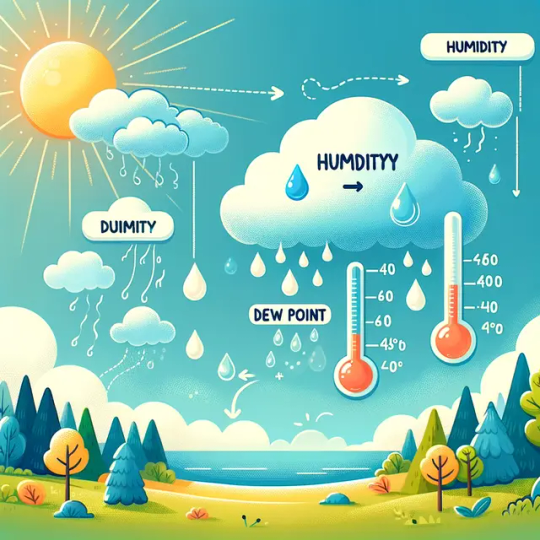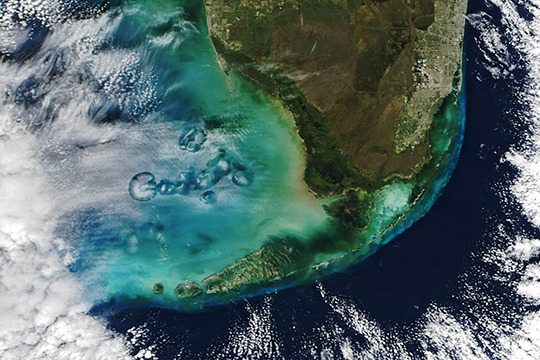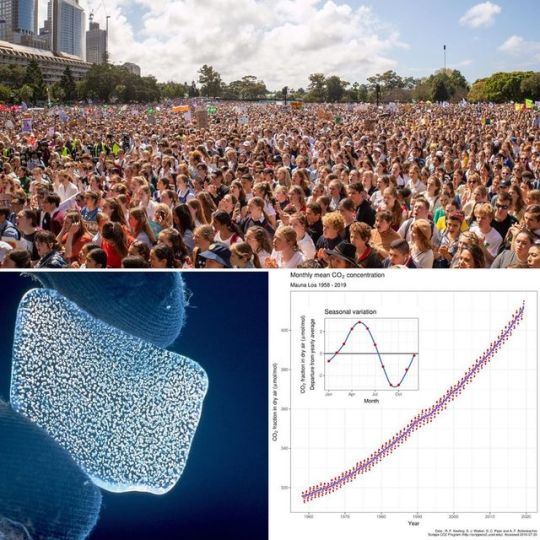#AtmosphericSciences
Explore tagged Tumblr posts
Text
Understanding air pollution from space
🧬 ..::Science & Tech::.. 🧬 Arlene Fiore uses satellite data paired with ground observations to refine our understanding of ozone smog and interactions with meteorology and climate
#MIT#Faculty#EAPS#Pollution#Ozone#Emissions#ClimateChange#GlobalWarming#Environment#Sensors#Satellites#ComputerModeling#AtmosphericChemistry#Geochemistry#Data#PublicHealth#Earth#AtmosphericSciences#SchoolOfScience
0 notes
Text
Are Humidity and Dew Point the Same?

Hey there! Have you ever wondered if humidity and dew point are the same thing? Well, they're related but not the same. Let's explore this in a way that's easy to understand.
What is Humidity?
Humidity is all about water vapor in the air. Think of it like an invisible water cloud floating around us. The more water vapor there is, the more humid it feels. You know those hot, sticky days in summer? That's high humidity!
Understanding Dew Point
Now, let's talk about dew point. This is the temperature at which air gets so full of water vapor that it can't hold anymore. When the air reaches this point, water condenses and forms dew. That's why it's called the dew point. It's like when your cold drink glass gets all sweaty on a hot day.
The Key Differences
So, what makes them different? Humidity measures how much water vapor is in the air, while dew point is about the temperature where water vapor turns into dew. High humidity means a lot of water vapor in the air. A high dew point means the air is close to getting full of water vapor.
Why It Matters
Understanding humidity and dew point helps us know how the weather will feel. High humidity and a high dew point can make it feel really muggy and uncomfortable. Weather forecasts use these to help us plan our day, like wearing shorts or carrying an umbrella.
In Conclusion
Remember, humidity is the amount of water vapor in the air, and dew point is the temperature where this vapor turns into dew. They work together to make our weather hot, cold, sticky, or dry. So next time you hear about humidity or dew point, you'll know they're not the same, but they're part of the same weather story!
#HumidityExplained#DewPointDemystified#WeatherBasics#ClimateEd#StudentMeteorology#AtmosphericSciences#WeatherVsClimate#UnderstandingHumidity#WaterVaporFacts#WeatherForecasting101#SciEd#EnviroScience#MiddleSchoolSTEM#WeatherPhenomena#TempAndMoisture
0 notes
Text
The Real Butterfly Effect

The butterfly effect -- that the flapping of a butterfly's wings in Brazil can cause a tornado in Texas -- expresses the sensitivity of a chaotic system to initial conditions. In essence, because we can't possibly track every butterfly in Brazil, we'll never perfectly predict tornadoes in Texas, even if the equations behind our weather forecast are deterministic. (Image credit: NASA; see also T. Palmer at Physics Today) Read the full article
#atmosphericscience#butterflyeffect#chaos#chaostheory#clouds#fluiddynamics#mathematics#meteorology#Navier-StokesEquations#physics#science#turbulence#weather
114 notes
·
View notes
Text

Atmospheric Chemistry
Atmospheric Chemistry is the branch of science that explores the chemical composition of Earth's atmosphere, its reactions, and its interactions with other parts of the Earth's system. This field studies natural and human-induced processes such as air pollution, greenhouse gas emissions, ozone layer depletion, and climate change impacts. Researchers utilize advanced tools like satellite observations, ground-based monitoring, and computational models to understand and address critical challenges in air quality, environmental sustainability, and global climate dynamics.
International Chemistry Scientist Awards
Website: chemistryscientists.org
Contact us: [email protected]
Nominate now: https://chemistryscientists.org/award-nomination/?ecategory=Awards&rcategory=Awardee
#sciencefather#researchawards#Professor,#Lecturer,#Scientist,#Scholar,#Researcher #AtmosphericChemistry #ClimateChange #AirPollution #GreenhouseGases #OzoneDepletion #EnvironmentalScience #EarthSciences #AirQuality #ClimateResearch #SustainableScience #AtmosphericScience #EnvironmentalChemistry #GlobalWarming #CarbonCycle #CleanAir
1 note
·
View note
Text
The Mystery of Rain | How Turbulence Shapes Our Weather
https://www.youtube.com/watch?v=_WvDy2vlqO4 Understanding how rain forms is crucial for improving weather and climate predictions. In this video, we explore groundbreaking research by the NSF National Center for Atmospheric Research (NCAR) that reveals how turbulence in clouds speeds up rain formation. By using advanced computer models and data from NASA’s field campaigns, scientists have uncovered key insights that could revolutionize weather forecasting. Dive into this exciting discovery and learn how it could lead to more accurate climate projections, better preparing us for the future. Source: National Center for Atmospheric Research. #atmosphericscience #meteorology #rain #weather #trendstorm #weatherscience #climatechange #rainforcast #turbulence #weatherforecasting #cumulusclouds #raindropscreation #environmentalscience #clouds #earthscience #nasaresearch #NSFScience #cloudformation #weatheranalysis #precipitation #weatherpatterns #hydrology #weathertech #earthatmosphere #weatherdata #environmentalresearch #scientificbreakthroughs #climatetech #computersimulation How does turbulence affect rain formation? The role of turbulence in weather prediction Understanding rain formation bottleneck Rain and cloud turbulence explained How do clouds form rain? Turbulence in cumulus clouds Advanced computer models for weather NASA's role in studying cloud formation The mystery of raindrop formation Rain formation and weather forecasting How does turbulence speed up rain? Cumulus clouds and turbulence The science behind rain initiation How weather models predict rain The impact of cloud condensation nuclei How do droplets turn into rain? NSF NCAR rain study Turbulence and rainwater mass The importance of turbulence in weather How computer simulations enhance forecasts NASA field campaign on rain formation How are raindrops formed in clouds? Turbulence's effect on cloud droplets Predicting rain with advanced models The physics of rain formation How weather models are improved Turbulence and rainfall amounts Rain formation in cumulus congestus clouds The role of turbulence in climate models Understanding cloud dynamics How turbulence impacts weather systems The science of droplet coalescence The future of weather forecasting How cloud particles affect rainfall Rainfall prediction and turbulence Turbulence's role in weather patterns Exploring cloud formation processes The connection between turbulence and rain High-resolution weather simulations The role of NASA in studying rain Understanding rain through computer models The process of raindrop growth Turbulence in atmospheric research Rain formation in different cloud types How clouds produce rain The science behind rain initiation Turbulence's impact on weather models How computer models predict rainfall The evolution of raindrops The significance of cloud condensation nuclei How turbulence influences weather forecasts The role of turbulence in the atmosphere The mystery behind rain formation Predicting rain with advanced simulations The relationship between clouds and rain How turbulence affects raindrop size The science of weather prediction Understanding cloud condensation nuclei The role of NSF NCAR in weather research Rain formation in turbulent clouds How weather models simulate rain The connection between turbulence and rainfall Exploring rain formation in clouds The impact of turbulence on weather systems Advanced simulations in weather research Understanding the rain formation bottleneck The science behind cloud and rain interaction Predicting rain with turbulence models How raindrops form in the atmosphere The physics of cloud and rain formation via Trend Storm https://www.youtube.com/channel/UCF1F2JAMftAe2z2hl32FXmQ August 21, 2024 at 05:30PM
0 notes
Text
Hurricane Beryl hits 150 mph near Carriacou in Windward Islands
New Post has been published on https://petn.ws/d421A
Hurricane Beryl hits 150 mph near Carriacou in Windward Islands
Storm surge is a killer in hurricanes but can be avoided FOX Weather hurricane specialist Bryan Norcross explains why storm surge can be higher on the west coast of Florida than the east coast. Hurricane Beryl strafed the tiny Windward Islands on Monday, July 1, in a riot of 150-mph winds as storm experts watched […]
See full article at https://petn.ws/d421A #CatsNews #Of, #2024, #2024HurricaneSeason, #Accidents, #AccidentsU0026Disasters, #Atmospheric, #AtmosphericScience, #Caribbean, #Colorado, #ColoradoStateUniversity, #Disasters, #Hurricane, #Hurricanes, #HurricanesWeather, #Miami, #Neutral, #Optimized, #Overall, #OverallNeutral, #PBPOST, #PBPOSTOptimized, #Science, #Season, #State, #Storms, #U0026, #University, #UniversityOfMiami, #Weather
#(of#2024#2024 hurricane season#accidents#Accidents u0026 Disasters#atmospheric#Atmospheric Science#caribbean#colorado#Colorado State University#disasters#hurricane#hurricanes#Hurricanes (weather)#miami#neutral#optimized#overall#Overall Neutral#PBPOST#PBPOST Optimized#science#season#state:#storms#u0026#university#University of Miami#weather#Cats News
0 notes
Text

WORLD METEOROLODICAL DAY
On World Meteorological Day, we the crucial role that meteorology plays in daily lives. Meteorology impacts everything from agriculture to transportation, and understanding the weather is essential for predicting natural disasters and protecting lives. In this video, we explore the importance of World Meteorological Day and the significant work done meteorologists around the world to keep us safe and informed.
Call:77997 99221 Webdite: www.manasadefenceacademy.com
#worldmeteorologicalday#meteorology#weatherforecast#climatescience#naturaldisasters#weatherpatterns#weatherprediction#atmosphericscience#weathermonitoring#climateresearch#climatechange#meteorologists#weatherdata#globalweather#climatology#worldweather#forecastingtools#weathertechnology#weatherobservations#weatherpatternsanalysis
0 notes
Photo

Exciting news! Two satellites named Tom & Jerry were launched to study the impact of shifting water masses on our planet's gravity field. 🛰️💧🌍 Follow their mission and discoveries with us! #TomandJerry #SatelliteLaunch #EarthGravity #WaterMasses #SpaceExploration #ScienceFacts #NewDiscoveries #NASA #SpaceNews #EmojisInSpace#TomAndJerrySatellites #WaterMasses #GravityField #SpaceMission #EarthExploration #SatelliteMapping #ClimateChange #GlobalWarming #ScienceResearch #SpaceScience #Astronomy #Geophysics #TechnologyAdvancement #Innovation #FutureProgress #Sustainability #EnvironmentalAwareness #NaturalResources #Oceanography #AtmosphericScience #PlanetEarth https://www.instagram.com/p/CpUVcjqtqwF/?igshid=NGJjMDIxMWI=
#tomandjerry#satellitelaunch#earthgravity#watermasses#spaceexploration#sciencefacts#newdiscoveries#nasa#spacenews#emojisinspace#tomandjerrysatellites#gravityfield#spacemission#earthexploration#satellitemapping#climatechange#globalwarming#scienceresearch#spacescience#astronomy#geophysics#technologyadvancement#innovation#futureprogress#sustainability#environmentalawareness#naturalresources#oceanography#atmosphericscience#planetearth
1 note
·
View note
Text

Interesting facts #25
0 notes
Photo

In 1961, monitoring of atmospheric gases by Charles David Keeling showed steadily increasing carbon dioxide levels. Poetry by Tom Sharp.
0 notes
Photo

IIT Delhi M.Tech Admission 2020- IIT Delhi releases the notification for admission of M.Tech course in 2020 session. Admission to M.Tech course in IIT Delhi for academic session 2020-2021 will be done by shortlisting as per GATE Score and the conducting test and interviews. The Indian Institute of Technology, Delhi is one of the top engineering colleges in India. The application form of M.Tech Admission 2020 available on the official website. #iit_delhi #m_tech #gate2020 # #admission #shikshaadvisor #textileengineering #electricalengineering #civilengineering #computerscienceengineering #mechanicalengineering #electronicsengineering #appliedmechanics #physics #chemistry #atmosphericsciences #IITs #iitdelhi #Masters #postgraduate #Mtech_admission (at IIT Delhi) https://www.instagram.com/p/B9ERifJAXiS/?igshid=1md0lbup44za7
#iit_delhi#m_tech#gate2020#admission#shikshaadvisor#textileengineering#electricalengineering#civilengineering#computerscienceengineering#mechanicalengineering#electronicsengineering#appliedmechanics#physics#chemistry#atmosphericsciences#iits#iitdelhi#masters#postgraduate#mtech_admission
0 notes
Text
Hole Punch Clouds

At times altocumulus cloud cover is pierced by circular or elongated holes, filled only with the wispiest of virga. These odd holes are known by many names: cavum, fallstreak holes, and hole punch clouds. (Image credit: M. Garrison; research credit: A. Heymsfield et al. 2010 and A. Heymsfield et al. 2011; via NASA Earth Observatory) Read the full article
#airplanes#atmosphericscience#cloudformation#clouds#fluiddynamics#freezing#hole-punchclouds#physics#science#supercooling
54 notes
·
View notes
Link
#advancedspacetechnology#astronautspreparingmission#atmosphericsci-fiimagery#breathtakingspacescenery#celestiallandscapeinspaceart#crewpreparestoexplore#futuristicinteriordesign#futuristicspaceship#high-techspacesuits#immersivesci-fiartwork#leonardoai#planetsurface#sci-fiartbyxzendor7#sci-ficonceptart#sci-fiexplorationtheme#sci-fifuturisticspaceship#sci-finarrativeartwork#spacemissionpreparation#xzendor7aiart
0 notes
Text

It's September 16th, 🇺🇳 International Ozone Preservation Day. On this day in 1987, the United Nations sponsored the 🇨🇦 Montreal Protocol on Substances that Deplete the Ozone Layer. This annual observance highlights the threats to our atmosphere's ozone layer, its relationship with climate change, and the steps we can all take to protect it from further damage.
In 1913, 🇫🇷 French physicists Charles Fabry and Henri Buisson discovered the ozone layer while measuring the Sun's radiation. Later research revealed that this fragile layer of ozone gas in our atmosphere protects the Earth from harmful ultraviolet rays, thus helping to preserve life on our planet.
In the late 1970s, scientists realized that human activity was destroying the ozone layer. They discovered a hole that was caused by ozone-depleting gases often found in air conditioners and refrigerators. Evidence of this ozone depletion manifested itself in many ways, including destruction of plants and ecosystems and increased incidences of skin cancer.
The international community rose to the occasion. In 1985, the United Nations adopted a formal declaration, the 🇦🇹 Vienna Convention for the Protection of the Ozone Layer, and then two years later put the Montreal Protocol into effect. Thanks to these successful efforts, the ozone layer is now healing. On September 16th, 2009, the Vienna Convention and the Montreal Protocol became the first United Nations treaties in history to achieve universal ratification. You see, we can work together. ☮️ Peace… Jamiese of Pixoplanet
#antarctica#arctic#atmosphere#atmosphericscience#cancer#cancerawareness#chemistry#chlorofluorocarbons#climatechange#earth#earthday#ecology#ecosystem#eczema#education#environment#everyactioncounts#geochemistry#globalwarming#health#healthyskin#hydrofluorocarbons#infertility#internationalozonelayerday#internationalrelations#leukemia#medicalscience#medicine#melanoma#melanomaawareness
1 note
·
View note
Photo

Without oceans and the atmosphere, Earth’s temperatures would be like the moon’s, which drop by hundreds of degrees after sunset. Winds on Earth carry warm air towards the poles and cool air towards the equator. Ocean-top currents carry warm water towards the poles and underwater currents carry cool water towards the Equator.
Info Source: Williams, J., & Travnicek, J. (2017). National Geographic Pocket Guide to the Weather of North America (Poc ed.). National Geographic.
Image Source: Heat Balance: Atmospheric Circulation. (n.d.). Atmospheric Circulation. Retrieved March 15, 2021, from http://www.ux1.eiu.edu/%7Ecfjps/1400/circulation.html
#geoscience#geosciences#geoscientist#atmosphere#atmosphericscience#meteorologist#meteorology#facts#facts‼️#littledidyouknow#sciencefacts#sciencefactslover#sciencenerd#sciencenerds
1 note
·
View note
Photo

September 2019 climate ⛅️ strikes. Also known as the Global Week for Future, climate strikes across the world spanning the week of the United Nations Climate Summit are likely to be the largest climate strikes in world 🌍 🌎 history. . More than 4 million people across the world are part of protests to demand leaders of the world to take action to address climate change. . Recent scientific data shows that atmospheric carbon dioxide levels have been increasing in recent history (bottom right). . On the other hand, atmospheric gases trapped in Antarctic and Greenland ice core samples provide key insights into the relationship between carbon dioxide levels and global temperatures to hundreds of thousands of years ago. . Along with isotopic carbon levels, the combined data reveals that burning of fossil fuels is primarily responsible for the current climate change. . Credit: CSIRO / CC BY 3.0, MCoblyn / CC BY 2.0 and Delorme/PTiens/NOAA/ESRL/RKeeling/Scripps Institute of Oceanography / CC BY-SA 4.0. . #climatechange #atmosphericscience #earthscience #globalclimatestrike #globalclimatechange #gretathunberg #icecore #antarctic #climatechangeisreal #planetearth #thereisnoplanetb https://www.instagram.com/p/B25qb8Khian/?igshid=4juf29k5bouw
#climatechange#atmosphericscience#earthscience#globalclimatestrike#globalclimatechange#gretathunberg#icecore#antarctic#climatechangeisreal#planetearth#thereisnoplanetb
2 notes
·
View notes